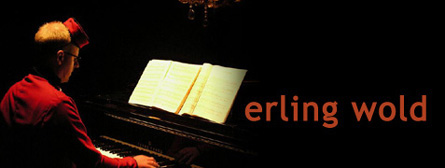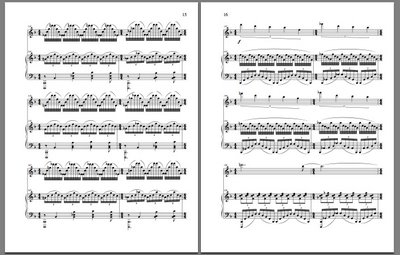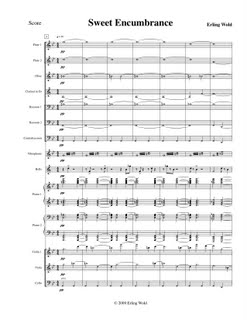 Continuing with the treacly investigation of romance and its elations, its euphoric pleasures, begun with Two Orchestral Waltzes for Lynne, the current work, Sweet Encumbrance, makes manifest, in sound, the joyous warmth, the sweet iron fetters and the small panics which flow from hogtying oneself together with one's chosen helpmeet and companion. In this piece, it is demonstrated in some detail how much one can gain in life simply by giving up one's philandering, and, while still given license to strut and flirt and still authorized to play the dandy, one must now, for the foreseeable future, festoon one's costume with the leash and collar and electronic ankle bracelet, sometimes visible but most often invisible, like the line that one might be enticed to cross save for the memories of the previous attempts' resultant truncheoning and electric shocks. But let us not dwell on such past pains, but please to look to that bright future world illumined by the brightest and whitest of most pure light where, joined in glory and set upon one's throne just to the right of the Empress, in a new Sagrada Familia, happily holding court, happily holding the hand of the one most beloved.
Continuing with the treacly investigation of romance and its elations, its euphoric pleasures, begun with Two Orchestral Waltzes for Lynne, the current work, Sweet Encumbrance, makes manifest, in sound, the joyous warmth, the sweet iron fetters and the small panics which flow from hogtying oneself together with one's chosen helpmeet and companion. In this piece, it is demonstrated in some detail how much one can gain in life simply by giving up one's philandering, and, while still given license to strut and flirt and still authorized to play the dandy, one must now, for the foreseeable future, festoon one's costume with the leash and collar and electronic ankle bracelet, sometimes visible but most often invisible, like the line that one might be enticed to cross save for the memories of the previous attempts' resultant truncheoning and electric shocks. But let us not dwell on such past pains, but please to look to that bright future world illumined by the brightest and whitest of most pure light where, joined in glory and set upon one's throne just to the right of the Empress, in a new Sagrada Familia, happily holding court, happily holding the hand of the one most beloved.
Saturday, September 26, 2009
Sweet Encumbrance
 Continuing with the treacly investigation of romance and its elations, its euphoric pleasures, begun with Two Orchestral Waltzes for Lynne, the current work, Sweet Encumbrance, makes manifest, in sound, the joyous warmth, the sweet iron fetters and the small panics which flow from hogtying oneself together with one's chosen helpmeet and companion. In this piece, it is demonstrated in some detail how much one can gain in life simply by giving up one's philandering, and, while still given license to strut and flirt and still authorized to play the dandy, one must now, for the foreseeable future, festoon one's costume with the leash and collar and electronic ankle bracelet, sometimes visible but most often invisible, like the line that one might be enticed to cross save for the memories of the previous attempts' resultant truncheoning and electric shocks. But let us not dwell on such past pains, but please to look to that bright future world illumined by the brightest and whitest of most pure light where, joined in glory and set upon one's throne just to the right of the Empress, in a new Sagrada Familia, happily holding court, happily holding the hand of the one most beloved.
Continuing with the treacly investigation of romance and its elations, its euphoric pleasures, begun with Two Orchestral Waltzes for Lynne, the current work, Sweet Encumbrance, makes manifest, in sound, the joyous warmth, the sweet iron fetters and the small panics which flow from hogtying oneself together with one's chosen helpmeet and companion. In this piece, it is demonstrated in some detail how much one can gain in life simply by giving up one's philandering, and, while still given license to strut and flirt and still authorized to play the dandy, one must now, for the foreseeable future, festoon one's costume with the leash and collar and electronic ankle bracelet, sometimes visible but most often invisible, like the line that one might be enticed to cross save for the memories of the previous attempts' resultant truncheoning and electric shocks. But let us not dwell on such past pains, but please to look to that bright future world illumined by the brightest and whitest of most pure light where, joined in glory and set upon one's throne just to the right of the Empress, in a new Sagrada Familia, happily holding court, happily holding the hand of the one most beloved.
Labels:
beauty,
composition,
lynne rutter,
music
Sunday, September 20, 2009
Missa fictus Missa ficta
One interesting set of audio interjections comes from a large belled clock in the sanctuary, which goes off from time to time during the recording, especially during the Sanctus, a highly synchronistic event, as the use of bells during the Sanctus goes back almost a millenium. Bells and the Bible go hand-in-hand, like love and glove, and the union produces such poetic gems as those found in Exodus 28:
And beneath upon the hem of it thou shalt make pomegranates of blue, and of purple, and of scarlet, round about the hem thereof; and bells of gold between them round about:
A golden bell and a pomegranate, a golden bell and a pomegranate, upon the hem of the robe round about.
And it shall be upon Aaron to minister: and his sound shall be heard when he goeth in unto the holy place before the LORD, and when he cometh out, that he die not.
Labels:
beauty,
composition,
mass,
music
Saturday, September 19, 2009
Teddy's biff
 My cross-dressing Teddy has a new best friend, seen here in her finery, harnessed safe and secure in the bosom of fellow pulse modulator and amateur Ruxpin engineer Mike, with whom I've been corresponding about the ins and outs of our little friend and his/her sensitivity to radio interference. I had planned to take my act to Burning Man a few weeks back to help investigate the Doors of Perception with the various misfits freaks and weirdos of which I am proud to call myself a member, but work in all its aspects has been impeding my fun lately. This must stop of course, and the prevailing winds are beginning to change, to blow to leeward, so soon maybe Teddy and I can appear in public again together. Meanwhile, li'l red above will have to take our place in the world.
My cross-dressing Teddy has a new best friend, seen here in her finery, harnessed safe and secure in the bosom of fellow pulse modulator and amateur Ruxpin engineer Mike, with whom I've been corresponding about the ins and outs of our little friend and his/her sensitivity to radio interference. I had planned to take my act to Burning Man a few weeks back to help investigate the Doors of Perception with the various misfits freaks and weirdos of which I am proud to call myself a member, but work in all its aspects has been impeding my fun lately. This must stop of course, and the prevailing winds are beginning to change, to blow to leeward, so soon maybe Teddy and I can appear in public again together. Meanwhile, li'l red above will have to take our place in the world.
Labels:
teddy ruxpin
Wednesday, August 19, 2009
Tabla lessons with Harihar Rao, with a side trip to Richard Feynman
 One day in tabla class - I studied on the side back in my scientific days at CalTech - some progressive-minded classmates and I, looking for a bit of spice and a bit tired of the (while often interestingly subdivided but still) powers-of-2 meters, goaded our teacher, Harihar Rao (top right), into amusing us with some rhythmic fireworks. Like all Westerners, we were always looking for something new and more exciting than what he was actually teaching us, never really willing to spend the time to learn the details of anything, like dancers seeming to hold their partners close but really looking past, scouting the next liaison across the room. But he had been teaching gringos like us for many years and so was used to this blasphemy and, with a weary acceptance, proceeded to teach us a somewhat complex 7 beat pattern. We then tried, a bit shakily, to keep this going, as steady as we could, as he straddled it with an 11 beat pattern, his beat effortlessly 11/7ths faster. It was a sweaty and joyous bit of concentration, collapsing and coming back together as we tried vainly to hold the two opposing rhythms in our head, to achieve what he could seemingly without thinking.
One day in tabla class - I studied on the side back in my scientific days at CalTech - some progressive-minded classmates and I, looking for a bit of spice and a bit tired of the (while often interestingly subdivided but still) powers-of-2 meters, goaded our teacher, Harihar Rao (top right), into amusing us with some rhythmic fireworks. Like all Westerners, we were always looking for something new and more exciting than what he was actually teaching us, never really willing to spend the time to learn the details of anything, like dancers seeming to hold their partners close but really looking past, scouting the next liaison across the room. But he had been teaching gringos like us for many years and so was used to this blasphemy and, with a weary acceptance, proceeded to teach us a somewhat complex 7 beat pattern. We then tried, a bit shakily, to keep this going, as steady as we could, as he straddled it with an 11 beat pattern, his beat effortlessly 11/7ths faster. It was a sweaty and joyous bit of concentration, collapsing and coming back together as we tried vainly to hold the two opposing rhythms in our head, to achieve what he could seemingly without thinking.For the few years I studied with Harihar, I couldn't walk anywhere without tabla rhythms appearing over the pulse of my step. It was an obsession, a compulsion. I would practice the patterns as I walked, like all drummers I have known since, making approximations of the sounds with my body, trying to fly each pattern against 3 beats, 4 beats, and 5 and 6 and on. The important thing - or what seemed so at the time - was to be able to perform it consistently while shifting one's concentration from one pulse to the other, flickering between views as with the Necker cube. Relative prime rhythms were of course the only ones that were interesting, like the relative primes that defined the intervals of which I was just becoming aware, and these rhythmic practices spilled out into my pianism, forcing me to play scales in polyrhythms, to add or subtract a beat or two or three to each measure of the left or right hand parts of just about anything to squeeze or expand them just a bit, a pleasant flurry of notes not quite lining up, like the middle bit of the first of the op. 28 Chopin préludes where the right hand switches from 6 to 5. [A note to the reader trying this at home: better is to move the right or left hand up or down a bit as well, a fifth or a third or whatever, and then, even better, to just stop playing other people's music as it's easier on the stereo anyway.]
I was lucky enough to attend CalTech when Richard Feynman was still teaching Physics X, and my friends and I would hang out there too, asking questions about the Moon and the blue sky and rainbows and gravitation and electron spin and DNA and the structure of the eye, learning more about science and its cousins in the barest refractions of light in the few smallest drops distilled from the great man's essences than in all of our more formal studies. The class wasn't really a class at all, but an informal seminar, held in the basement somewhere, maybe Lauritsen, where the students would ask questions about anything, attempting and failing to stump the great man, and where Feynman would always cut through to the heart of each issue, bringing an oh-so-pleasant shock of illumination and intuition.
CalTech was a strange and insular place, a tremendous opportunity for those who were prepared to take advantage of it, suicidally difficult for others, stocked with children who had been locked away, sequestered from society from birth by the nature of their interests and their antisocial smarty-pants disposition. But, even in that rarified place, where Nobel Laureates were dime-a-dozen, Feynman was an icon who floated a bit above the rest. When he showed up to our tabla class one day, we were suitably star-struck and tongue tied, unable to respond to his easy manner. His bongo playing was well-known to us, and well as some of his other idiosyncrasies - one I remember well is when he showed up at a meeting of the CalTech Christian students simply to point out what idiots they were for believing against all facts and logic - but in the end the instrument was beyond him, and he an old dog trying to learn a few last tricks, the sounds too subtle and he too impatient to coax them out of the hide.
Tuesday, August 18, 2009
This year's CDs
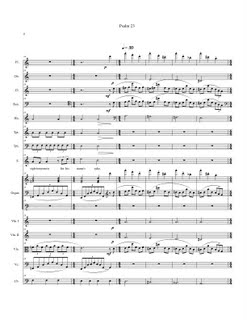 The compact disc of my Missa, although wholly encapsulating a sad and dying medium of auditory exchange, is at least visually luminous and beguiling thanks to Karen and should be available quite soon, as soon as I can bring myself to go through all the recordings of both performances in some detail and make a final determination of what is the best and what is not. The chalice awaits the thick nectar of the reverb-heavy-laden music decanted, then held to the lips to succor those in spiritual need. Although I have attempted to interest a few of the typical classical music vendors in the product, it will be a vanity press item, made simply for the delight of my fans and so that I can continue to gaze longingly at my own reflection.
The compact disc of my Missa, although wholly encapsulating a sad and dying medium of auditory exchange, is at least visually luminous and beguiling thanks to Karen and should be available quite soon, as soon as I can bring myself to go through all the recordings of both performances in some detail and make a final determination of what is the best and what is not. The chalice awaits the thick nectar of the reverb-heavy-laden music decanted, then held to the lips to succor those in spiritual need. Although I have attempted to interest a few of the typical classical music vendors in the product, it will be a vanity press item, made simply for the delight of my fans and so that I can continue to gaze longingly at my own reflection.The Mordake CD, on the other hand, is mixed and packaged and has obtained the all-important record deal, only now awaiting approval from a thousand bureaucrats, dressed each identically in their identical indigo Mao costumery, soon to be unfettered, alive and on its own in the uncaring world.
Thursday, August 13, 2009
Bunnywhiskers once again
 My dear friend Bunnywhiskers has moved her radio show to a new time and a new location and has asked me to ennoble her and her program by appearing, tonight, the 12th of August, 2009, two days past the Perseid peak, on FCC Free Radio at 107.3 on your FM dial here in San Francisco, or streaming online at the address you just passed over. We will talk of many things, surely including music and love and grace, and read excerpts from favored books and maybe the libretto from my upcoming production, possibly even giving away a free CD. All is possible. For those of you coming across this entry in the future, there may be a link to a recording of the show here.
My dear friend Bunnywhiskers has moved her radio show to a new time and a new location and has asked me to ennoble her and her program by appearing, tonight, the 12th of August, 2009, two days past the Perseid peak, on FCC Free Radio at 107.3 on your FM dial here in San Francisco, or streaming online at the address you just passed over. We will talk of many things, surely including music and love and grace, and read excerpts from favored books and maybe the libretto from my upcoming production, possibly even giving away a free CD. All is possible. For those of you coming across this entry in the future, there may be a link to a recording of the show here.
Labels:
art,
beauty,
bunnywhiskers,
radio
Wednesday, August 12, 2009
Bletchley Park etc
 As a former mathematician and reputed engineer, I've shared the recent nerdish interest in the true idea that World War II was really won by the boy and girl geeks who prodded and cajoled roomfuls of vacuum tubes and who lovingly sharpened their No. 2 pencils and who, on their long walks home, flirted and kissed furtively against romantic revival gingerbreaded walls, and that we Anglo-Americans, by our braininess alone, knew all the Axis powers' plans and played the war like a great chess game, not through the efforts of the poor filthy pawns who slogged through the mud and death and blood to capture and hold bits of land, captives of that distasteful space.
As a former mathematician and reputed engineer, I've shared the recent nerdish interest in the true idea that World War II was really won by the boy and girl geeks who prodded and cajoled roomfuls of vacuum tubes and who lovingly sharpened their No. 2 pencils and who, on their long walks home, flirted and kissed furtively against romantic revival gingerbreaded walls, and that we Anglo-Americans, by our braininess alone, knew all the Axis powers' plans and played the war like a great chess game, not through the efforts of the poor filthy pawns who slogged through the mud and death and blood to capture and hold bits of land, captives of that distasteful space.The reality is somewhere in between of course, although I did always wonder why it took so long for the engineers' roles to be understood. The truth was quite slow to arrive, and not until the 70s did the British government allow publication of Bletchley Park's breaking of the Enigma codes, for many reasons, my favorite of which is the fact that the Brits had sold the rotor machines to their former colonies throughout the world and hoped to continue to read all their diplomatic traffic. The secret business is a set of wheels within wheels, and there is great fascination in the work of statisticians deciding which bits of intelligence to follow and which to ignore, which will show the enemy too much knowledge of our knowledge and which can be safely hidden, possibly in other obfuscating and pointless missions, and who will be allowed to be killed by enemy attack, and who will be saved.
Outside of the rarified air of Bletchley Park there were also other, lower tech operations, some chronicled in the fascinating book Between Silk and Cyanide by Leo Marks, who tells stories of encryptions in the field, used by operatives behind enemy lines, some using bits of one-time pad sewed into bits of silk parachute material, others using memorized poems, the most famous of which is his own romance The Life That I Have, perhaps made more poignant by the context, where Nazi handlers may have beaten this poem and others like it from those they captured, turning them as agents to work against the land and people they loved:
The life that I haveIs all that I haveAnd the life that I haveIs yoursThe love that I haveOf the life that I haveIs yours and yours and yours.A sleep I shall haveA rest I shall haveYet death will be but a pauseFor the peace of my yearsIn the long green grassWill be yours and yours and yours.
Labels:
cryptography,
engineering,
nazi
Tuesday, August 11, 2009
The youth
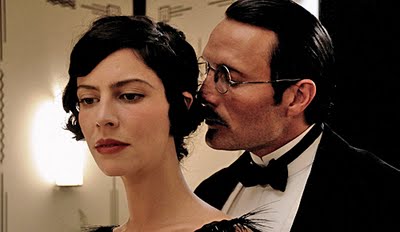
from Conversations with Igor Stravinsky, late '57:
I have all around me the spectacle of composers who, after their generation has had its decade of influence and fashion, seal themselves off from further development and from the next generation. Of course, it requires greater effort to learn from one's juniors, and their manners are not invariably good. ... The very people who have done the breaking through are themselves often the first to try to put a scab on their achievement. What fear tells them to cry halt? What security do they seek, and how can it be secure if it is limited? How can they forget that they once fought against what they have become?I have to admit that it is v. difficult for me to learn from my juniors. My typical reaction to the artistic successes of freshly minted composers is envy and jealousy tempered only by rage, depression and frustration, and although, in my case, I really have very little that I am fighting for, except my own self-aggrandizement, as I am an eclectic and polyamorous lover of styles and ideas and threads of artistic development, it's hard for me to get past the pettiness that so pervades my soul. But in deference to the idol of my youth, I resolve to try.
And I was intrigued to recently discover the brief affair between the young Igor and Coco Chanel, now a motion picture, see above.
Labels:
composition,
tips for better living
Saturday, August 1, 2009
More on Teddy
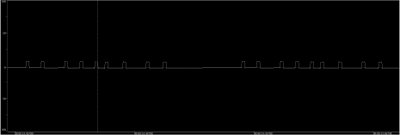
Pictured at the top is a detail of two quasi-periods of the control track, consisting of a set of nine positive-going pulses. Each pulse is about .25 msec wide, actually .27 for the 'blue box' I built so many years ago, and the time between pulses is what controls the servos. That is, the time between pulse 0 and pulse 1 in each group of nine controls one servo, and the distance between pulse 1 and pulse 2 controls the next, and so on. The time between pulses from a fully open to a fully closed servo varies from about 1.25 msec to 2 msec, measuring from leading edge to leading edge. The leading edge of pulse 0 of next group of nine is about 6.5 seconds from the leading edge of the last pulse of the previous group of nine. The total period of the groups is not fixed - you can hear the overall pitch change as they move. My main bear is one of the two servo variety, and for that animal the interval from pulse 1 to pulse 2 controls the eyes and from pulse 2 to pulse 3 controls the mouth. Later bears had a separate control for upper and lower jaw, and if you hook Teddy to Teddy's friend Grubby®, a pleasantly disgusting and seemingly out of scale and of a different cartoon aesthetic big grub-like creature, you will find that the other pulse to pulse modulations come into play to control him as well.
Originally I sent the control signal in using a CD to cassette adaptor and then recorded actual cassettes, but as I've resurrected the project in more recent days I decided to do some surgery (note crime-scene-like photo above) and bypass the heads on the crappy built-in cassette player. I attached a mini phone jack directly past the play heads and it seems to work to send the signal in from a dime-a-dozen mp3 player. One has to be a bit careful of the levels - too high or too low on the control track and the bear becomes subject to a variety of muscle spasms or alternately is sent into a catatonic state. Also, running the low-level wires out of the bear makes it subject to radio interference, and cell phones held close to the bear can also elicit the abovementioned palsies. I went a little further and hooked up battery powered amp/speaker combination inside since the built in speaker is also pretty bad. It's meant to be heard by a small child sitting in a quiet room alone with the somewhat scary bear toy and is not quite up to entertaining a packed opera house.
Labels:
art,
beauty,
teddy ruxpin,
theater
Thursday, July 23, 2009
Duncan Wold's score for In Residence
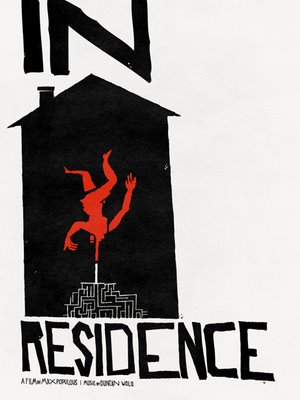 My son, showing that he is a child of the same Adam, has constructed a heavenly collection of musical fragments, a Soundscape for a Nonexistent Motion Picture, but which, by its synopsis, makes one strongly wish for its actual production:
My son, showing that he is a child of the same Adam, has constructed a heavenly collection of musical fragments, a Soundscape for a Nonexistent Motion Picture, but which, by its synopsis, makes one strongly wish for its actual production:This haunting film is not for the faint of heart — or the claustrophobic. We are presented with Jane, an artist who begins a residency at a strange home filled with junk. Her goal is to fashion the detritus into a piece of artwork speaking to the theme of recycling and ‘green’ building practices. But things get twisted when the junk compels her to construct an elaborate and, at times, beautiful trap for herself, which she slowly begins to realize is locking her in, pressing her downward into infinite, interlocking chambers. Even as she becomes more entangled in the web of the house, it begins to provide her with sustenance necessary to continue her work.
— Dina Bloomberg, Down the Rabbit Hole Zine
Labels:
beauty,
composition,
duncan,
film,
music
Wednesday, July 8, 2009
I have nothing to wear and I am wearing it
 and that is poetry, in this case the poetry of Bunnywhiskers resting her tired coney body after a day's hunting and being hunted, me the eternal gentleman.
and that is poetry, in this case the poetry of Bunnywhiskers resting her tired coney body after a day's hunting and being hunted, me the eternal gentleman.
Labels:
art,
beauty,
bunnywhiskers
Saturday, July 4, 2009
Teddy
But the other venture, which has been favorited by more than one of my erstwhile fans, was a small piece done in a small venue in Oakland, where I performed a duet with a Teddy Ruxpin® which centered on themes of objectophilia and robot sex in the modern world. In fact, the exact animatronic doll sitting on my desk today in the photo above being prepared for a comeback tour of sorts next month. You can see the blue pulse timing modulation box I built back in my 'maker' days to control its servos and to allow me to make my own, more sophisticated control tapes. My son, who was about 2 at the time, loved it, although it's possible that some of the themes may have gone over his head. He giggled all through the preceding performance that evening, in which a topless and somewhat buxom young butoh dancer, powdered in white, completed, in about ten minutes, a short walk down an incline.
Since the script was quite short, I reproduce it here for your amusement. As my wife was the voice actor for the bear, I performed a small transgendering of Teddy to Trary, and put a bit of ribbon in his hair.
I would very much like you to meet one of my very good friends. Say hello to everyone, Erling.
Um, why did you bring it up?
(pause)
I think I am in the mood to sing a song for all the people here. Could you accompany me on the accordion, Erling?
ERLING Sure. (Trary and Erling perform The Second Prayer from A Little Girl Dreams of Taking the Veil.)
Labels:
composition,
electronic music,
music,
teddy ruxpin
Saturday, June 20, 2009
Denisova-Kornienko Duo
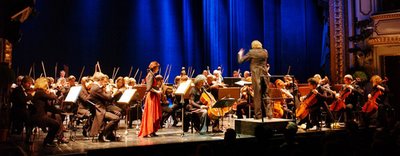 I met Elena and Alexei when they performed in the 2001 Austrian production of A Little Girl Dreams of Taking the Veil, Alexei on the podium and Elena covering the viola, my favorite bit of which is the brief and registrally displaced but oh so beautiful solo here:
I met Elena and Alexei when they performed in the 2001 Austrian production of A Little Girl Dreams of Taking the Veil, Alexei on the podium and Elena covering the viola, my favorite bit of which is the brief and registrally displaced but oh so beautiful solo here:
I had promised them a piece in their roles as the members of a violin-piano duo, and this for many years, giving them only one small number that was a simply bit of program music, an old man dies, a vision of my own death as an old man, gasping for breath but all the while still dreaming of a breast, the iconic breast of a woman. However, I finally forced myself to sit down and write something, not asking them if they still cared or wanted the heavy responsibility of another piece dedicated to them, this one not quite so simple. This spicy opus, The Secret of Success, a reference to a blog entry here by the same name, is subtitled a chaconne, because it is, at least a bit, and in the modern meaning as a set of variations on a repeating harmonic progression, in this case a series of chords rooted on Bb, a combinatorial set that treads between major and minor, similar to those I have used before: once in The Bed You Sleep In and once in the Cotter episode in Queer. The piano plays incessantly, often verbosely, and typically the harmonic changes happen right on the measure line, one per measure, violin and piano almost always changing together, something that Kyle Gann would probably find crazy making. From a recent post of his that was on my mind while I was scribbling:
When I see a kid composing in units of measure, measure, measure, with a new impetus, new phrase, new harmony on every downbeat, I start in with my wheedling tone (every experienced composition student will recognize the sound): "How about a triple upbeat to start that melody off a little more gracefully?" "How about we vary the harmonic rhythm here?" "You think the audience can't hear where your bar-lines are if you don't accent every one?"
Labels:
beauty,
composition,
electronic music,
opera
Serb Cutter
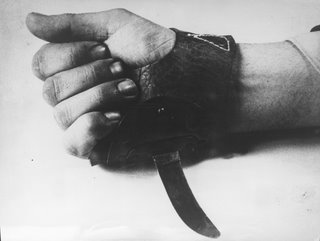 My beloved foreign correspondent sent me a note this morning reminding me of some of the more brutal of the brutalities of the last Great European war. He found it as he was researching a new novel which has something to do with the concentration camps in the Balkans, but it also reminded me of a story. Around the time when the event more recent troubles began in the region, my friend Mark Dippé was visiting some Serb friends in Sarajevo. At the moment they heard that their Serb brothers and sisters had launched a campaign of slaughter against their Croat brothers and sisters, he said that they, seemingly modern and reasonable people up to that point, literally jumped up with joy at the opportunity to grab their weapons and get to killing. It is of course hard for us, civilized with our mountains of McDonald's and hundreds of channels of TV, to understand such depth of hatred, but my correspondent's link did explain just a bit of it. It's just a small thing, the above device, a Srbosjek, or "Serb cutter," but it represents so much, and was invented by the Ustaše - Croatian Revolutionary Movement - as a way to efficiently slit the throats of captured Serbs, of which there were very very many, while engendering in the murderer as little fatigue as possible.
My beloved foreign correspondent sent me a note this morning reminding me of some of the more brutal of the brutalities of the last Great European war. He found it as he was researching a new novel which has something to do with the concentration camps in the Balkans, but it also reminded me of a story. Around the time when the event more recent troubles began in the region, my friend Mark Dippé was visiting some Serb friends in Sarajevo. At the moment they heard that their Serb brothers and sisters had launched a campaign of slaughter against their Croat brothers and sisters, he said that they, seemingly modern and reasonable people up to that point, literally jumped up with joy at the opportunity to grab their weapons and get to killing. It is of course hard for us, civilized with our mountains of McDonald's and hundreds of channels of TV, to understand such depth of hatred, but my correspondent's link did explain just a bit of it. It's just a small thing, the above device, a Srbosjek, or "Serb cutter," but it represents so much, and was invented by the Ustaše - Croatian Revolutionary Movement - as a way to efficiently slit the throats of captured Serbs, of which there were very very many, while engendering in the murderer as little fatigue as possible.
Labels:
competition,
nazi
Saturday, June 13, 2009
Night and fog
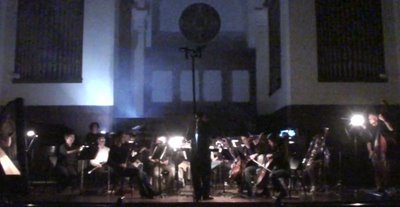 Tonight is the night, and the SFCCO players are sounding good. A few complaints and threatened defections from the orchestra over the fog, but they are into it, what started as a stretch has now become commonplace. And I'm so happy to get my noise self out. Michael Cooke has told me it's his favorite piece of mine ever, and he's heard a lot. It is to go on the shelf with other obscure pieces of mine (the 49ers opera, the Trary Ruxpin accordion duets) that have become my friends' favorites?
Tonight is the night, and the SFCCO players are sounding good. A few complaints and threatened defections from the orchestra over the fog, but they are into it, what started as a stretch has now become commonplace. And I'm so happy to get my noise self out. Michael Cooke has told me it's his favorite piece of mine ever, and he's heard a lot. It is to go on the shelf with other obscure pieces of mine (the 49ers opera, the Trary Ruxpin accordion duets) that have become my friends' favorites?
The Artist as a Young Whore
 I was asked to participate this morning in a paid interview - in cash, in the form a single piece of currency: the bill with the drunken general and the corrupt president - by the San Francisco Foundation, and it got me to thinking about my whorish nature, a term I use with the ultimate in positive connotations, as many whores are counted among my best friends, and I can only aspire to such clear thinking and take-charged-ness.
I was asked to participate this morning in a paid interview - in cash, in the form a single piece of currency: the bill with the drunken general and the corrupt president - by the San Francisco Foundation, and it got me to thinking about my whorish nature, a term I use with the ultimate in positive connotations, as many whores are counted among my best friends, and I can only aspire to such clear thinking and take-charged-ness.
Anywho, getting to the point, it's clear that artists have always been quick to leech onto whomever is in power, regardless of their goodness or badness, in order to live their lives of dissipation, shrouding their selfish wants in pseudo-mystical-art-feeds-the-soul bologna. I'm reminded how, in de imperio tertio, we find the same willingness to suck at the monied teat of the all-father to further one's career, although, in the case which came to mind, it may not have been the best choice career-wise. Heinrich Hoffman, who became more-or-less the official photographer of the Führer, took the photograph above and many others, note especially those Hitler suffering the little Aryan Children to come unto him, but who, after the war, was imprisoned for profiteering and who had all his photographs seized and put into the US National Archives, the images themselves consigned to the public domain.
Leni Riefenstahl, shown naked above, who also had all her work expropriated by the incoming GIs, was never quite able to lie her way out of the stigma of being infatuated with the Nazis and Nazi ideals and, even though she was clearly one of the greatest aestheticians in the early days of the new art form, she was rejected by the world she and her friends had abused, project after project denied after the war. But she saw the slaughter of the Kinsk civilians, she chose the particular slave Gypsies for her films, she allowed them to be shipped to Auschwitz, she knew what was to happen to them but she litigated against all who said so, indefatigably, during her long long life. And who can forget Albert Speer, the one who apologized, but who was also only to eager to be seduced by the power and the money and the evil structure of which he became a part.
But I suppose the difference is that the artists of the US of today are happy to take the blood money and spend it biting the hand that fed them, and feeling entitled to the privilege all the same.
But I suppose the difference is that the artists of the US of today are happy to take the blood money and spend it biting the hand that fed them, and feeling entitled to the privilege all the same.
Sunday, May 17, 2009
Intuitionism
 Bath-time this morning was facilitated by an iPhone 3G® in a Ziploc® bag - thanks to my friend Nicole for enlightening me of this wonderful invention - and a circuitous path through those intoxicating days early in the last century where Hilbert and Brouwer led the fight over the non-finitary law of the excluded middle (see photo) and other such issues.
Bath-time this morning was facilitated by an iPhone 3G® in a Ziploc® bag - thanks to my friend Nicole for enlightening me of this wonderful invention - and a circuitous path through those intoxicating days early in the last century where Hilbert and Brouwer led the fight over the non-finitary law of the excluded middle (see photo) and other such issues. As a boy, I was so interested in all of this. The issues seemed so important and, later, as I became a composer, I faced them again, feeling a pressure from above to maintain an intellectually rigorous Germanic methodology in all my musical decision making, a certain belief promulgated by my betters that there was a notion of music that existed in a Platonist reality where deep truths live separate from the dirty business of breath and bows and spit and turntables and stylish hairdos, and that compositional progress was in the furtherance of passage toward this Utopian Ideal.
But I was, deep down, more tolerant, and shall we say more Dutch, and believed that music really was purely an act committed by people for their own amusement, that it existed in this world and not the other, and that it had benefits beyond an explication of existence, namely (0) transcendental beauty here on earth (1) encouraging teen pregnancy through passionate embrace (2) a devil-may-care use of drugs (3) hearing impairment in the elderly (4) separation of fools from their money (5) penis casting (6) nonpareil spirituality and mystical joy (7) creative jouissance (8) and so on, and that music was concerned with the grit and chaos and noise of sound, and that it was, at its core, an inexplicable and impenetrable pursuit, evading all attempts to capture it, drop it in the killing jar, and to pin its beautiful wings to the setting board. The theories I learned as a student did not attempt to cover anything except what I found to be the most superficial aspects of music, the voices and pitches and rhythms, and I was left to find the rest myself.
One of the reasons I started writing - English rather than notes - was to try to explain what I did day-by-day during the compositional process, thinking that in so doing I might capture the uncapturable. But I've failed every time that I have tried. I can't really say easily what I do. There is no process to speak of, and the moments spent in the compositional state sneak by unseen to end up in a piece that I no longer feel my own.
Labels:
beauty,
composition,
music
Friday, May 15, 2009
"But at least they dressed well"

As a young boy on the Great Plains, gorged on a constant diet of WWII war movies and television, my friends and I would get together with our BB guns and cherry-bombs to be mini-reënactors, and, in our innocence, who would we vie to be? The sloppy GI with perpetual cigarette hanging out of his mouth, unshaven? Hardly! No, we fought for the right to click our heels, to salute, to wear the smartly trimmed Hugo Boss designed and built SS uniforms, to carry an imaginary Feldmarschall's baton, and to speak in a clipped Germanesque pidgin, the hint of a saber cut on our cheek, the monocle, the goose-step.
As children, we could be forgiven, having no idea of the signification of our choice. But many elect to continue this into adulthood, as its very taboo nature titillates and appeals, from the Korean ad above (video here), to Nazi themed restaurants, to the Nazi Chic, to those too interested in the paraphernalia of the Reich. What to make of these fallen and so foolish fellow humans? Have they forgotten or merely never learned that the fascist path, while seeming to wander along an alpine meadow, dotted here and there with some wildflowers, leads to the cliff or to the bear or to both?
Score Directions
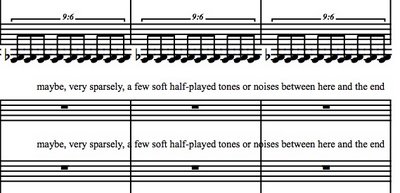 The score is done, the parts have been shipped away once again, and, while usually one for absolute control - a chimera at best - I have abrogated my responsibility as a Komponist to allow the so-called performers a bit of leeway, one arm unbound from the straightjacket, a rest from the hamster wheel, the industrialist lightening for the moment the blows on the backs of the restive workers, but this philosophical change of heart, like most, has come from expediency rather than deep thought, as my compositional laziness seems to increase year upon year. I remember a day in the not so distant past where, to begin the simplest of tunes, I first had to build the instruments, sawing and sanding into the wee-est hours to the ire of my roommates, decide on a tuning, and, locked in my slattering studio, learn to play the aforementioned devices or at the least to coax a sound. But now my compositional life has settled into a pattern: (1) agree to a deadline (2) wait until the last possible moment (3) use every shortcut, trick, careless theft and accident to produce something as quick as possible. I had lunch with my friend and co-producer Paul Dresher the other day and had to hide my head in shame after listening to him describe the months of preparation on Shick Machine, building the instruments, learning to ... yes, you get the idea, everything I had been, and revealing to all the shadow I have become.
The score is done, the parts have been shipped away once again, and, while usually one for absolute control - a chimera at best - I have abrogated my responsibility as a Komponist to allow the so-called performers a bit of leeway, one arm unbound from the straightjacket, a rest from the hamster wheel, the industrialist lightening for the moment the blows on the backs of the restive workers, but this philosophical change of heart, like most, has come from expediency rather than deep thought, as my compositional laziness seems to increase year upon year. I remember a day in the not so distant past where, to begin the simplest of tunes, I first had to build the instruments, sawing and sanding into the wee-est hours to the ire of my roommates, decide on a tuning, and, locked in my slattering studio, learn to play the aforementioned devices or at the least to coax a sound. But now my compositional life has settled into a pattern: (1) agree to a deadline (2) wait until the last possible moment (3) use every shortcut, trick, careless theft and accident to produce something as quick as possible. I had lunch with my friend and co-producer Paul Dresher the other day and had to hide my head in shame after listening to him describe the months of preparation on Shick Machine, building the instruments, learning to ... yes, you get the idea, everything I had been, and revealing to all the shadow I have become.
Labels:
composition,
music
Wednesday, May 13, 2009
In the Stomachs of Fleas

We, that is, fognozzle and Erling Wold, present for you a tale of fear, horror, xenophobia, political posturing and denial, all contained within a musical program piece of sorts, a savage delight for the senses and an allegory for today, this and that and the other thrown into the pot of narrative and boiled up into a scenario as follows:
The Australia steamed into San Francisco in 1899, carrying corpses and rats infected with the plague. Between 1900 and 1904, one hundred twenty-six people contracted the disease in San Francisco and environs. One hundred twenty-two of them died while the governor denied the very existence of the plague and the press blamed the Chinese for spreading it.
The plague was brought under control in 1904, only to resurface in 1906 as the great earthquake displaced the human and rat population. The response to this second outbreak was dealt with more efficiently as the causes were better understood, but one hundred eighty people died of the plague in San Francisco between 1906 and 1909.
Fortunately, Xenopsylla cheopis (the Oriental rat flea) never secured a foothold in San Francisco, and our dominant flea remained Ceratophyllus fasciatus, which lacked the deep stomach required for effective plague transmission. Many more people would have died if the reverse had been true.
Unfortunately, the rat-eradication efforts during the San Francisco plague outbreaks did not extend to the squirrels of the East Bay. Through them, the bubonic plague established a permanent foothold in the Pacific Northwest, where it lives on today - in the stomachs of fleas.
SAN FRANCISCO COMPOSERS CHAMBER ORCHESTRA
and Old First Concerts Present:
DREAMS OF THE RESTLESS
Saturday June 13th, 2009 at 8 pm
Old First Presbyterian Church
1751 Sacramento Street/Van Ness, San Francisco, CA 94109
$15 General, $12 Seniors (65 and older), $12 Full Time Students
DREAMS OF THE RESTLESS
Saturday June 13th, 2009 at 8 pm
Old First Presbyterian Church
1751 Sacramento Street/Van Ness, San Francisco, CA 94109
$15 General, $12 Seniors (65 and older), $12 Full Time Students
Labels:
beauty,
composition,
electronic music,
music,
sfcco
Subscribe to:
Posts (Atom)
